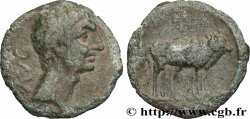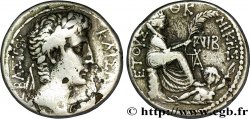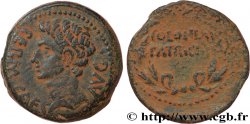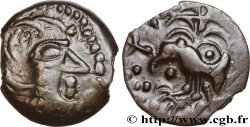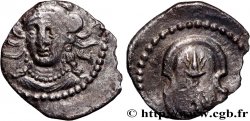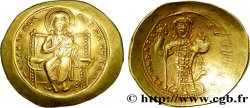bpv_295731 - AUGUSTUS Tétradrachme syro-phénicien
无库存.
所有在网站上销售的产品 (2014)
价格 : 350.00 €
所有在网站上销售的产品 (2014)
价格 : 350.00 €
种类 Tétradrachme syro-phénicien
日期: An 27 et 12e consulat
铸币厂名称/城市 Antioche, Syrie, Séleucie et Piérie
材质 silver
直径 26 mm
模子方针 12 h.
重量 14,00 g.
出版目录中的项代码 :
家谱
Cet exemplaire est le 0050_044 de la base TSP
正面
正面的说明书 Tête laurée d’Auguste à droite entouré de la stemma (O*).
正面铭文 KAISAROS SEBASTOU (Kaisaros Sebastou)
正面的翻译 (César Auguste).
背面
背面的说明书 Tyché (Ville d’Antioche) tourelée, voilée et drapée assise à droite sur un rocher, tenant une palme de la main droite ; à ses pieds à droite, l’Oronte nageant à droite.
背面铭文 ETOUS - sK - NIKHS/ (UPAT) IB (Etous Nikhs)
背面的翻译 Nouvelle année victorieuse 26 / Douzième consulat / monogramme d’Antioche.
评论
Ce type, qui s’étend de l’an 27 (5 AC) à la mort de l’Empereur, en l’an 44 du règne (14 AD) présente un type religieux plus œcuménique que ceux qu’utilisèrent les Séleucides : la Tyché de la ville d’Antioche.
On peut penser que l’Antioche de l’époque, probablement une ville de 150 à 200.000 habitants, était un creuset de cultes différents et que les Romains, plutôt que d’imposer un dieu particulier, choisirent une image dans laquelle tous les Antiochéens, voire tous les habitants de la région, pouvaient se reconnaître. La statue de la Tyché représentée au revers, était la statue cultuelle de l’artiste Eutychides, si célèbre que des copies d’époque nous en sont parvenues.
Dans la base TSP maintenue par Michel Prieur, quatre-vingt quinze exemplaires sont maintenant répertoriés dont dix en musées et collections publiques (Berlin, deux exemplaires, British Museum, Oxford, Yale, Paris, Vienne, Copenhague, Gotha et Glasgow).
This type, which extends from the year 27 (5 BC) to the death of the Emperor, in the year 44 of the reign (14 AD) presents a more ecumenical religious type than those used by the Seleucids: the Tyche of the city of Antioch. We can think that Antioch of the time, probably a city of 150 to 200,000 inhabitants, was a melting pot of different cults and that the Romans, rather than imposing a particular god, chose an image in which all the Antiochians, or even all the inhabitants of the region, could recognize themselves. The statue of the Tyche represented on the reverse, was the cult statue of the artist Eutychides, so famous that examples of it from the period have come down to us. In the TSP database maintained by Michel Prieur, ninety-five examples are now listed, including ten in museums and public collections (Berlin, two examples, British Museum, Oxford, Yale, Paris, Vienna, Copenhagen, Gotha and Glasgow)
On peut penser que l’Antioche de l’époque, probablement une ville de 150 à 200.000 habitants, était un creuset de cultes différents et que les Romains, plutôt que d’imposer un dieu particulier, choisirent une image dans laquelle tous les Antiochéens, voire tous les habitants de la région, pouvaient se reconnaître. La statue de la Tyché représentée au revers, était la statue cultuelle de l’artiste Eutychides, si célèbre que des copies d’époque nous en sont parvenues.
Dans la base TSP maintenue par Michel Prieur, quatre-vingt quinze exemplaires sont maintenant répertoriés dont dix en musées et collections publiques (Berlin, deux exemplaires, British Museum, Oxford, Yale, Paris, Vienne, Copenhague, Gotha et Glasgow).
This type, which extends from the year 27 (5 BC) to the death of the Emperor, in the year 44 of the reign (14 AD) presents a more ecumenical religious type than those used by the Seleucids: the Tyche of the city of Antioch. We can think that Antioch of the time, probably a city of 150 to 200,000 inhabitants, was a melting pot of different cults and that the Romans, rather than imposing a particular god, chose an image in which all the Antiochians, or even all the inhabitants of the region, could recognize themselves. The statue of the Tyche represented on the reverse, was the cult statue of the artist Eutychides, so famous that examples of it from the period have come down to us. In the TSP database maintained by Michel Prieur, ninety-five examples are now listed, including ten in museums and public collections (Berlin, two examples, British Museum, Oxford, Yale, Paris, Vienna, Copenhagen, Gotha and Glasgow)







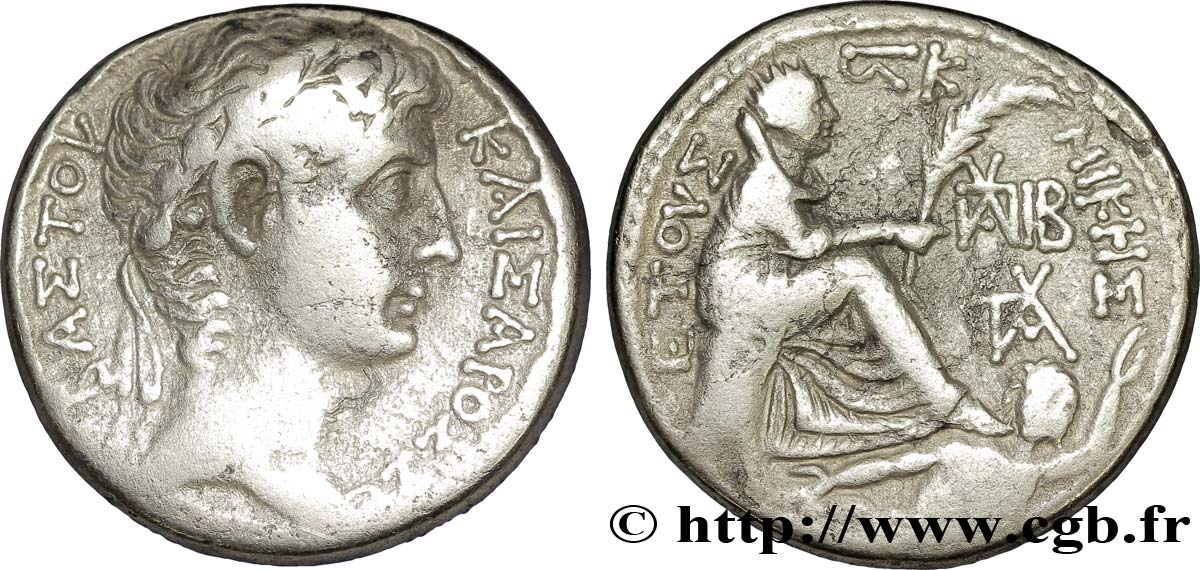
 对产品描述纠错
对产品描述纠错 打印
打印 分享我的选择
分享我的选择 提问
提问 Consign / sell
Consign / sell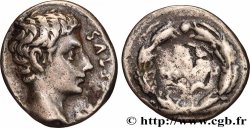
 产品介绍
产品介绍